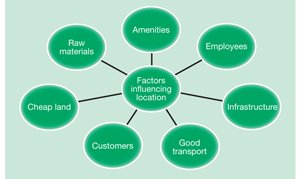
One of the most important decisions a business has to make is where to locate. The location of the business can have a significant effect on how it performs. Businesses will aim to operate from locations that provide the maximum competitive advantage. These decisions need to be reviewed regularly.
By selecting the best location, a business could get more customers, improve its efficiency and generate greater profits. For example, choosing an out-of-town shopping park instead of a high street may allow a retail business to have greater shop space, better overheads and attract more customers because parking is easier.
Multinational businesses need to make many decisions about the location of their operations. At an international level, they might need to choose which countries or territories to operate within to maximise opportunities. Within each country, they would need to locate the head office. At a more local level, they may need to choose whether to locate within or around major cities.
Enterprise Rent-A-Car is an internationally recognised brand, operating within the United States, Canada, the UK, Ireland and Germany. It is the UK’s largest car rental company. As the company has developed, it has sought to retain the personal feel of a smaller business.
The company encourages its branch managers to take responsibility for local operations. This approach helps to create a dynamic service driven by the individual branches. This means that each branch is free to focus on the needs of its local customers, while delivering Enterprise’s values and high standards of customer service.
Competitive market place

Car rental is an extremely competitive market. There are many car rental companies operating in the UK. Enterprise aims to outperform its competitors through a focus on customer service. Service is a core element of Enterprise’s ethos and as such, employees seek to provide the highest standards of customer care. This is the driving force and key differentiator of the business.
As part of this strategy, Enterprise attempts to locate its branches as close as possible to its customers. It has an extensive branch network. Within the UK, the company operates from 350 locations. Most people (over 75% of the country’s population) live within five miles of an Enterprise branch.
This case study focuses on how Enterprise Rent-A-Car decides where to locate its new or relocated branches.
Factors affecting the location of a business
There are several reasons why an organisation might decide to open new branches or relocate its existing operations. It might want to expand the business, so it will open branches in cities where the organisation did not previously have a presence.
A business might also want to restructure or modernise its operations. It might do this by bringing together some existing departments into new purpose built premises. It might decide to shut its less profitable operations and open branches in locations that offer more business potential.

A business will have to consider many factors when determining where to locate a new branch or operation. Usually, it will have to balance several factors in making a decision. Sometimes one factor may sway the decision:
- It may choose a site with the cheapest land or buildings.
- It might decide on a location that is convenient for key employees. A business needs to be able to recruit staff with the right skills base.
- It might choose a site that has easy access to raw materials. For example, many frozen food factories are located near fishing ports to reduce transport time taken and to keep fish fresh.
- The key factor could be the transport and service infrastructure. Many businesses require easy access to good road and railway links and modern telecommunication services. These ensure that they can meet service or delivery deadlines.
Enterprise Rent-A-Car is a service business. Its customers include:
- businesses, who may require regular car rentals for their staff or visitors
- individual customers, who may want to hire a car when they are on holiday or if their own vehicle has been involved in an accident.

Enterprise makes it as easy as possible for customers to use its services. For example, business customers may need a car delivered to their doorstep. Alternatively, retail customers can use Enterprise’s unique pick-up service, where the customer will be collected from their location and taken back to the branch to collect the car.
Customers can also pick up cars direct from branches, so all Enterprise sites need to have good transportation links and easy access. They also need to be close to their customers. This helps to ensure Enterprise can keep its promise to customers on the speed and efficiency of its service.
Types of locations:
Enterprise has branches in two types of locations:
- First, there are ‘home/city’ branches. These are located in areas close to long-term business partners, as well as to a large market for personal customers. These branches meet the demand for car rental from businesses and individuals wanting a car for accident cover or for leisure purposes and represent 95% of all Enterprise’s locations.
- Second, there are branches at airport locations. These provide a service for people flying into or out of a region.
By locating branches in busy areas and near to its customers, Enterprise can also increase awareness of its services by using its premises to project a strong visual brand. The signs and fittings at each branch premises display the Enterprise corporate logo and reflect the company’s colours and branding.
Enterprise also needs to be open to changing customer demand. For example, a major new housing development may generate a new source of customers in an area. The growth of residential housing could also encourage new businesses, such as shops and offices, to open nearby to provide services and goods to this new market. Enterprise needs to be in a position to adapt its locations to meet any changes in its market efficiently.
Return on investment
When an organisation makes an investment, it is taking a business risk. When a company spends money on opening or moving to a new location, it will hope to see a return on this investment through increased profits. For example, by opening a new branch close to a buoyant or developing market, the business would hope to increase its sales. This in turn should lead to higher profits.
Setting up a new Enterprise branch generates costs. These relate to:
- set-up costs, such as for obtaining planning permission decorating and fitting out the buildings and installing fire alarms and security
- fixed costs, including rent and other overheads such as heating and lighting
- variable costs, which will depend on the volume of business. These include staff salaries – as the business grows, a company will hire more staff – and, for Enterprise, the cost of owning and maintaining vehicles.
There are several ways in which Enterprise assesses whether a new branch or relocation will generate sufficient return on the required investment. The starting point for any method of investment appraisal is to forecast how much additional revenue the new operation will generate.
However, this also needs to be considered against how much that business may take away from other Enterprise locations nearby. This revenue forecast can then be used to obtain a profit forecast.
Projected revenues and profits
Projected revenues and profits can be linked back to costs in several ways:
- Payback measures the length of time it will take to generate sufficient profit to cover the costs of the initial investment. When assessing different project options, companies sometimes choose the project that has the shortest payback period.
- Return on capital employed expresses the amount of profit generated in a given period (usually a year) as a percentage of the costs of the project. Investors would usually only back projects where this percentage is greater than prevailing bank interest rates. It would make little sense to back a business project if investors could get a greater return by simply keeping their money in a bank account.
- Break-even analysis is a way of assessing how long it will take (or how many customers are required) for a new business venture to generate a profit. This analysis relates sales revenue to total costs. The break-even point is achieved when the revenue equals the costs incurred to date.
A large multi-national company like Enterprise may sometimes take a location because it offers a strategic advantage. For example, it may stop a competitor obtaining the location or may be situated in a developing area where the longer term projections are very good.
Identifying a new location
Before selecting a new location for a branch, Enterprise undertakes a detailed analysis. Initially, local managers identify the potential of possible new locations. This is done through a detailed process of forecasting based on existing information, such as how many customers currently use each branch. This process enables the business to spot where existing branches are at maximum capacity and where there might be opportunities for new branches to win business from competitors.
At this early stage, managers look at the population in the catchment area of the proposed new branch. They assess how many cars have been rented by customers in this catchment area from surrounding branches. They aim to understand the amount of business in the area, as well as what level of business is currently being missed because Enterprise does not have a presence in that local market.
Enterprise sets a boundary for a new location aiming to be within a six-minute drive time for its customers. It also needs to be close to referral sources, such as vehicle repair centres, mechanics and dealerships. These are some of the places where Enterprise may acquire new customers, such as people who urgently need a rental car because their own car has broken down or been involved in an accident.

Once it has been decided to establish a branch in a particular location, Enterprise managers consider the suitability of potential sites. Enterprise needs its branch sites to have good access and parking space. They should be easy to get to at all times. If the area around the site experiences frequent traffic jams, this might inconvenience customers and create negative perceptions of Enterprise’s service.
Enterprise managers undertake an initial property analysis to see if a site is worth further investigation. They use a comprehensive checklist to evaluate each location. This includes looking at other planning applications being made in the area, estimating the cost of setting up the branch and considering the impacts promotional signs will have at and around the site.
Enterprise sets high standards
Enterprise sets high standards so that every new branch will provide a better service for customers. For example, the new Enterprise Rent-A-Car branch at Heathrow airport has a convenient and accessible position between the airport junctions on both the M4 and the M25 motorways. This means customers coming from different directions can find it easily. It also has prominent signage to make it easier for customers to see where they should leave rental vehicles that are being returned.
The new branch also has operational advantages for Enterprise. It is a bigger site and allows more efficient operations. Its location means that shuttle times to the airport terminals have reduced. It now takes 10 minutes less to transfer customers from the Enterprise offices to the terminal buildings.
The new branch also offers Wi-Fi and has a rest area for customers. The improved facilities not only mean customers generally feel more comfortable, but also that business people can keep using email and internet whilst waiting.
Qualitative influences
There are also other factors that influence Enterprise in its choice of location for a new site. It is important that safety requirements are met, for example, making sure the road conditions are suitable. Ideally, there should be the space to expand operations in the future, so managers assess if the local facilities and infrastructure will allow this.
Managers also take into account environmental considerations. Enterprise aims to make new branches as environmentally-friendly as possible:
- Long-life bulbs are used within Enterprise signage. These last five times longer than standard bulbs. This reduces environmental waste and cuts the labour hours spent replacing bulbs.
- Photocells are used to switch on outside lights and signs only when they are needed. This reduces electricity consumption.
- Regulators are placed on car wash and jet wash machines to reduce the amount of shampoo used.
- Printing is kept to a minimum and documents are only printed on recycled paper.
- A ‘last person out’ switch turns off all non-essential electrical devices at the end of the day.
- Special window blinds reduce heat gain, which reduces energy costs.
- Offices use efficient lighting that generates less heat, so that cooling systems are not required.
- Furniture is recycled by donating replaced items to charities.
As there are 7,700 Enterprise Rent-A-Car branches worldwide, even small environmental improvements at branch level produce a big difference globally.
Conclusion
Setting up new branch locations gives Enterprise the opportunity to expand the business and improve on the quality of its customer service. The key factor that often differentiates a service business from its competitors is the quality of the care and attention given to customers.
When looking for new sites, Enterprise aims to locate the business as close to customers as possible. This means that it can respond more quickly to their requirements. It also makes it more easy and convenient for customers to access the services of Enterprise.
In evaluating potential new locations, Enterprise also aims to address environmental concerns. During refurbishments and the setting up of new branches, Enterprise puts in place measures to reduce the carbon footprint of the business. This not only improves the customer experience, it also helps Enterprise to reduce its costs and grow as a business.
